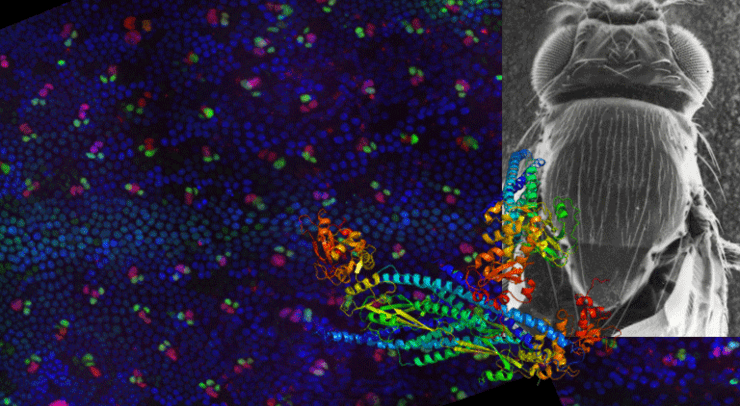The fruit fly as search data against cancer

The objective assigned to the ROBUST Project is to study the stability of cell cycles in Drosophila (or aka fruit flies) and thereby update the gene networks involved in the process. This is the first collaboration between the UTC Applied Maths Laboratory (LMAC) and the Development Biology Laboratory (LBD) at UPMC (University of Paris 6 – Pierre & Marie Curie); each team had to adapt to the work methods and protocols of the other team…
Investigations on cell cycles are legion, notably because they relate to cancer research programmes. This is indeed the framework for the ROBUST project, financially supported after a call for projects launched by the Sorbonne Universities Cluster (SU) in 2014.
“In fact, it was the UPMC-LBD Lab who contacted us, with the proposition that we model part of their research work”, recalls Ghislaine Gayraud, a research scientist at UTC-LMAC, The project — jointly initiated by Ghislaine Gayraud, Pascal Moyal (who is also a research scientist at LMAC), Frédérique Peronnet and Michel Gho (senior research scientists at the LBD) — started in October 2014 and was planned for one year.
This study of cell cycle stability calls for a model, developed by Michel Gho’s team, of the mechano-sensorial bristles on the drosophila’s thorax. “The cells that compose the bristles on the fly’s thorax undergo a special cell cycle known as an “endocycle””, explains Frédérique Peronnet. “These cells correctly replicate their genetic material, but do not subdivide, becoming ‘polyploid’. Polyploidy is associated with a higher cell growth rate; hence, we can deduce that the length of the bristle is proportionate to the number of endocycles is has undergone by its cells and the variation in bristle size also signals variations in the number of endocycles involved”.
The ROBUST Project models the distribution of bristles on the fly’s body, integrating bristle development through time. The resulting growth pattern is filmed in Michel Gho’s lab and the bristles are visualized using various fluorescent markers. “Thanks to this experimental set-up, we are able to follow the number of endocycles and hence the progression of bristle formation”, details Michel Gho. Modelling the genesis of bristles allows us to better understand the development of these sensory organs.The observations are then carried out under reference conditions those corresponding to “normal” flies and again under conditions where protein cyclin G has an induced deregulation, disturbing the normal function. “Cyclin G has been a well-preserved protein during evolution, notably in vertebrate animals, with its two forms (G1 and G2)”, explains Frédérique Peronnet.
“It now has been shown that they can be deregulated in numerous carcinogenic processes, without our understanding what is the cause of the disturbance or the consequence, i.e., the development of a cancer. Our study aims at characterizing the role of this protein in the stability of the cell cycles? We use drosophila because we know it only hosts one cyclin G and that greatly simplifies out investigations. The films we make will show the dynamics of the endocycles for each cell, depending on whether it contains a deregulated or non-deregulated cyclin G, and in this way we hope to identify the final effect on bristle growth and what genes precisely are involved in the growth patterns observed, ” adds Ghislaine Gayraud. “If the number of endocycles decreases, there will be less large cells and the bristles will be either truncated short or simply absent”.
Lastly, the gene networks necessary for bristle development will be identified, by studying the differences in gene expression in the cells that precede growth of the bristles, under normal conditions and when the Cyclin G is disturbed. “Gene graph studies are developing rapidly today”, asserts Ghislaine Gayraud. “In our particular study, probably only several hundred genes were involved. That already is quite a large amount for a graph study, especially when there are lots of nodes, viz., the genes, but not that many significant links among them”.
Once the gene characteristics have been identified, new experiments could be conducted for the purpose of identifying more precisely their function in bristle growth, as well as teaching us more about the role of the cyclin G.




